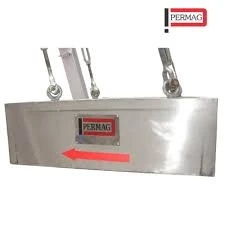Suspended Magnet Best Practices for Industrial Settings
Suspended magnets, also known as overhead magnets or crossbelt magnets, are powerful magnetic separators used in industrial settings to remove unwanted ferrous metal contaminants from materials such as ores, coal, recyclables, and other processed materials. These magnets are typically suspended above conveyor belts or other material handling equipment to attract and extract ferrous metal particles, preventing them from entering downstream processing equipment or causing damage to machinery. To ensure the safe and efficient use of suspended magnets in industrial settings, it is important to follow best practices for their installation, operation, and maintenance. In this blog post, we will discuss some of the key best practices for using suspended magnets in industrial settings.
Choose the Right Type and Size of Magnet: When selecting a suspended magnet for your industrial application, it is important to consider the type and size of magnet that best meets your needs. Suspended magnets come in various types and sizes, including electromagnets and permanent magnets, with different magnetic strengths and dimensions. The type and size of magnet you choose will depend on factors such as the type of material being processed, the volume of material being conveyed, the size and weight of the ferrous contaminants, and the distance between the magnet and the material being processed. It is essential to consult with a qualified engineer or magnet supplier to determine the appropriate type and size of magnet for your specific application.Proper Installation: Proper installation of suspended magnets is crucial to ensure their effectiveness and longevity. Here are some best practices for installing suspended magnets in industrial settings:Follow manufacturer's instructions: Follow the manufacturer's installation instructions carefully to ensure the magnet is installed correctly. This includes proper positioning, spacing, and alignment of the magnet with the conveyor belt or material handling equipment.Adequate support structure: Ensure that the support structure, such as the suspension system and brackets, are adequately designed and installed to support the weight of the magnet and withstand the operational forces.Safe access: Provide safe access to the magnet for inspection, maintenance, and cleaning purposes. This may include installing walkways, stairs, and handrails as required by local safety regulations.
Regular Inspections: Regular inspections of suspended magnets are essential to ensure their proper functioning and to identify any signs of wear or damage that may require maintenance or replacement. Here are some best practices for inspecting suspended magnets:Visual inspection: Conduct visual inspections of the magnet, including its suspension system, brackets, and electrical connections, for any signs of wear, damage, or misalignment. Pay special attention to areas where the magnet may come into contact with material or other equipment.Magnetic field strength testing: Regularly test the magnetic field strength of the magnet using a gauss meter or other appropriate testing equipment. Compare the measured field strength with the manufacturer's specifications to ensure that the magnet is operating within its designed performance parameters.Cleanliness: Keep the magnet and its surrounding area clean and free of debris that may interfere with its performance. Clean the magnet regularly and remove any accumulated material or contaminants.
Proper Operation: Proper operation of suspended magnets is essential to ensure their optimal performance and to prevent any safety hazards. Here are some best practices for operating suspended magnets in industrial settings:Proper power supply: Ensure that the magnet is supplied with the correct voltage and current as specified by the manufacturer. Use appropriate wiring and electrical connections to prevent overloading or damage to the magnet.Proper controls: Use appropriate controls, such as control panels, remote controls, or interlocked switches, to safely operate the magnet. Follow the manufacturer's recommendations for the operation of the magnet, including any specified duty cycle or operating temperature.Avoid overloading: Avoid overloading the magnet by exceeding its recommended capacity or passing too much material too quickly. Overloading can reduce the magnet's effectiveness and may cause damage to the magnet or other equipmentProper material handling: Ensure that the material being conveyed or processed is evenly spread across the conveyor belt or material handling equipment to ensure optimal contact with the magnet. Avoid dumping large amounts of material in one area, as it may cause uneven loading and reduce the magnet's effectiveness.Monitoring: Regularly monitor the performance of the suspended magnet during operation. Keep an eye on the material passing through the magnet and check for any signs of ferrous contaminants or metal build-up on the magnet surface. If there are any issues or changes in performance, take appropriate actions, such as adjusting the magnet's position or cleaning it, to maintain optimal performance.
Safety Considerations: Safety should be a top priority when working with suspended magnets in industrial settings. Here are some best practices to ensure the safe use of suspended magnets:Training and education: Ensure that all personnel who work with or around suspended magnets are properly trained and educated on their safe operation, including the potential hazards associated with working with magnetic equipment.Personal protective equipment (PPE): Require all personnel to wear appropriate PPE, such as gloves and safety glasses, when working with or near suspended magnets to protect against potential injuries from moving parts or metal debris.Lockout/tagout procedures: Develop and implement proper lockout/tagout procedures to ensure that the suspended magnet is de-energized and locked out before performing any maintenance, inspection, or cleaning activities.Hazardous environments: If the industrial setting where the suspended magnet is being used has hazardous environments, such as areas with explosive or flammable gases or dust, ensure that the magnet is designed and installed to meet the appropriate safety standards and requirements for those environments.
Maintenance and Repairs: Regular maintenance and prompt repairs are critical to keep suspended magnets in optimal working condition. Here are some best practices for maintenance and repairs:Follow manufacturer's recommendations: Follow the manufacturer's recommendations for maintenance and repair procedures, including scheduled inspections, cleaning, lubrication, and component replacement.Prompt repairs: Promptly address any issues or damages identified during inspections or during the normal operation of the suspended magnet. Do not ignore signs of wear, damage, or reduced performance, and take appropriate actions, such as repairs or replacements, to ensure the magnet's continued effectiveness.Use genuine parts: When replacing components or parts of the suspended magnet, always use genuine parts from the original manufacturer to ensure the magnet's integrity and performance.Keep records: Maintain detailed records of all maintenance and repair activities, including dates, procedures, and any changes made to the magnet. This information can be valuable for troubleshooting, warranty claims, and future reference.
Training and Emergency Preparedness: Proper training and emergency preparedness are crucial for dealing with any unexpected situations related to suspended magnets. Here are some best practices:Training: Provide regular training to all personnel involved in the operation, maintenance, and inspection of suspended magnets. The training should cover proper operation, maintenance, safety procedures, emergency procedures, and potential hazards associated with working with magnetic equipment.Emergency procedures: Develop and implement clear emergency procedures, including procedures for dealing with power failures, equipment malfunctions, and incidents such as metal pieces getting caught in the magnet. Ensure that all personnel are familiar with these procedures and know how to respond in case of an emergency.
In conclusion, suspended magnets are powerful tools used in industrial settings to remove ferrous metal contaminants from materials. To ensure their safe and efficient use, it is crucial to follow best practices for their installation, operation, and maintenance. This includes choosing the right type and size of magnet, proper installation, regular inspections, proper operation, safety considerations, maintenance and repairs, as well as training and emergency preparedness. By following these best practices, you can maximize the effectiveness and longevity of your suspended magnet, minimize downtime, reduce safety risks, and optimize your overall industrial process.
PERMAG is a leading supplier of magnetic stick, and we are committed to providing our customers with the highest quality products available on the market. Thanks to our state-of-the-art manufacturing process, we are able to produce magnetic rods that meet the most stringent quality standard.


